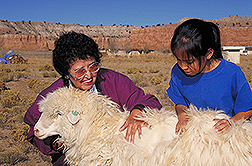This page has been archived and is being provided for reference purposes only. The page is no longer being updated, and therefore, links on the page may be invalid.
Read the magazine story to find out more. |
|
Protecting Sacred Sheep
By Marty ClarkApril 11, 2005
Agricultural Research Service scientists are working with the Navajo tribe of the American Southwest to protect Navajo-Churro sheep, which are culturally important and sacred to the tribe.
Researchers at the ARS National Center for Genetic Resources Preservation (NCGRP) in Fort Collins, Colo., want to ensure that there's enough genetic material stored and readily available to reintroduce animal or plant species, if necessary. The NCGRP germplasm collection includes numerous breeds of cattle and pigs, as well as sheep.
Animal geneticist Harvey Blackburn, responsible for the animal collection at NCGRP, and animal physiologist Phil Purdy plan to collect 6,000 units of semen from Navajo-Churro rams. The researchers have already gathered 1,200 semen samples from 27 different rams, but they hope to get samples from at least 50 rams for broader diversity.
The breed of sheep known as Navajo-Churro came to the Southwest five centuries ago via Spanish settlers. The Navajo tribe has raised the breed since then, although over time, others convinced the tribe to raise different breeds, so the Navajo-Churro numbers dwindled. At one time, there were more than 2 million Navajo-Churro. In 1977, when conservation efforts began, there were fewer than 500. Today, the number has grown to about 1,500.
Navajos use the Navajo-Churro wool to weave blankets. Non-Navajo handspinners prefer the wool and will pay premium prices for it.
Read more about the research in the April 2005 issue of Agricultural Research magazine.
ARS is the U.S. Department of Agriculture's chief scientific research agency.

